 |
Flavors of China > Jiangsu Cuisine or Su Cuisine - also called Huaiyang Cuisine
Yangzhou, Nanjing, Suzhou and Zhenjiang
Huaiyang cuisine is the name given to the culinary tradition that developed very early in China around the prefectures of Yangzhou, Nanking, Huai'an and Zhenjiang in Jiangsu province. In fact, it dates back to before the Christian era to the Spring and Fall period, the early part of the eastern Zhou dynasty between 771 and 481/453 BCE. It flourished under the Sui, Tang, Ming and Qing dynasties. Before the Ming and Qing era, Huai'an and Yangzhou were prosperous cities renowned for the sophistication of their cuisine. Huai cooking was already recognized as one of the four cuisines of China. After the end of the Ming and Qing dynasties, Huai and Yang cuisines amalgamated due to their many similarities. Thus it was that “Huaiyang” cuisine was born, a contraction of the names Huai'an and Yangzhou. This is said to be the cradle of imperial cuisine because many cooking methods were developed here, including that for Peking duck.
Located some 70 km from Nankin, Yangzhou was for a long time an important crossroads in the salt trade because it was located right on the Emperor’s canal. Therefore, in the Middle Ages, it became a prosperous and powerful commercial city. Marco Polo, it is said, even spent several years here as governor on behalf of the sovereigns of the Yuan dynasty. All the merchandise of southern China destined for the imperial court was amassed here; these goods were then loaded onto boats which, taking the Grand Canal, travelled all the way to Peking. Many mandarins and emperors came to stay or cross the region. It was also said that its inhabitants were among the richest in the empire.
The Huaian-Yangzhou-Zhenjiang region is traditionally considered the “rice basket” of China. It is a fertile region: rice, wheat, pork, fish, seafood from the Yellow Sea and freshwater crab form the basis of this rich cuisine, at once mild and spicy, salty and sweet. The region also provides corn, barley, peanuts, and sweet potatoes, but the most common vegetable is white cabbage which tends to be called Chinese cabbage and which is used in soups, braised or fried.
Huaiyang cuisine embodies harmony, neither too salty nor too sweet. It has delicacy as its essence and health as its goal. It can be summed up as follows: mild flavor, delicacy and elegance of presentation, harmony of colors and choice of key ingredient.
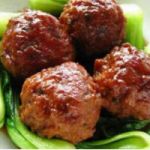
Lion’s head (Braised meatballs)
The name of this dish is due to its size, which is typically three times that of regular meatballs. The meat is hand chopped, formed into a round shape, and pan-fried to seal in the juices. It is then slowly braised in a dark sauce consisting of soy, vinegar, wine, sugar and cornstarch.
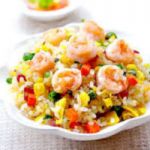
Yangzhou fried rice
Yangzhou fried rice is the classic dish in the city of Yangzhou. Day-old rice is necessary because freshly cooked rice is too sticky. Eggs are scrambled in advance and mixed with the fried rice. Other variations include the addition of cooked diced cured sausage, shrimp, ham, green beans, carrots, peas, corn, bamboo shoots, green onion, etc. According to legend, Yangzhou fried rice was brought to Yangzhou by Emperor Yang of the Sui Dynasty when he visited Yangzhou.
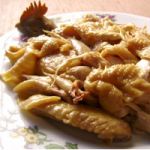
Beggar’s chicken
A whole chicken marinated in five spice, wrapped in lotus leaves and mud and then roasted. If prepared well, you should easily be able to pick the meat off the bone with your chopsticks. This dish is almost never prepared at home because traditional Chinese residences typically do not have ovens .
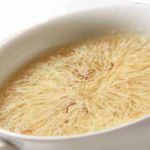
Wensi Tofu
Wensi Tofu is a notable traditional dish in Huaiyang cuisine with a long and significant history. Tofu is cut as fine as hair. According to legend, it was invented by a monk named Wensi in the years of Emperor Qianlong, Qing Dynasty. Tofu is mixed with mushroom, winter bamboo shoots, ham and chicken breast, depending on the season and availability and added to bean soup.
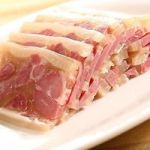
Pork Trotter Aspic Jiangsu Style
Pork trotter aspic, a famous dish in traditional Huaiyang cuisine, has a history that goes back more than 300 years. The cooked dish is as transparent as crystal, hence the name. The cleaned pork trotter is boiled for three or four hours in spiced soup until it becomes crisp. The pork trotter is put into a flattened carton, and once cool, taken out and cut into little cubes.
Famous dishes include sweet and sour mandarin fish, chicken pieces with egg white, boiled salted duck, boiled crab meat in clear soup and steamed shad.
Lion's Head - Chine Voyage International
Yangzhou fried rice - Cokemomo
Beggar chicken: limpidsheep

-

 Recipes
Recipes
-

 Products
Products
-

 Entertaining
Entertaining
-

 Chefs
Chefs
-

 Hints & Tips
Hints & Tips
-

 Glossaries
Glossaries








